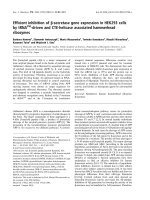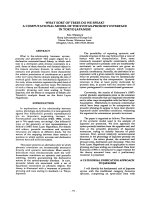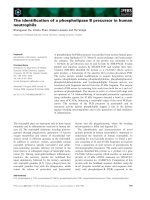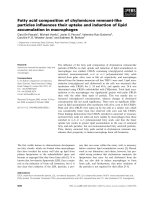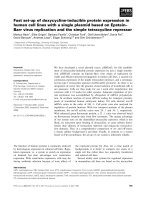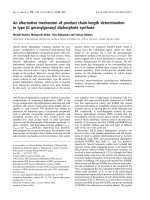Báo cáo Hydrogeological Characterisation and Groundwater Protection of Tropical Mountainous Karst areas in NW Vietnam
Bạn đang xem bản rút gọn của tài liệu. Xem và tải ngay bản đầy đủ của tài liệu tại đây (3.64 MB, 152 trang )
Hydrogeological Characterisation
and Groundwater Protection
of Tropical Mountainous Karst areas
in NW Vietnam
by
Vu Thi Minh Nguyet
Department of Hydrology and Hydraulic Engineering
V U B – HYDROLOGIE (48)
2006
i
This publication is Nr. 48 of the series “V U B – Hydrologie” edited by the Department
of Hydrology and Hydraulic Engineering, Vrije Universiteit Brussel.
Orders should be sent by letter to the Department of Hydrology and Hydraulic
Engineering, Vrije Universiteit Brussel, Pleinlaan 2, B-1050 Brussels.
c
2006 Dienst Uitgaven VUB
Wettelijk depot 1885
This dissertation is dedicated to Mr. Thai Duy Ke,
our respectful, good-hearted, beloved colleague and great friend,
who is always alive in our memory.
i
Acknowledgments
This thesis owes much to the help and support of many people, all of whom have contributed
in different ways.
First of all, I would like to express my sincere gratitude and appreciation to my promotors,
Prof F. De Smedt and Dr. N. Goldscheider, for their valuable guidance, fruitful discussions
and consistent support that made it possible for me to finish this work. I am grateful to
Dr. O. Batelaan for his suggestions, practical help and support on my work over many years.
I would like to thank the Directorial Board of the Research Institute of Geology and Mineral
Resources (RIGMR) for the strongly support on my work; to Prof. Duong Duc Kiem,
Pham Binh, Nguyen Tam, Dang My Cung and many senior researchers and colleagues at
RIGRM for the professional advice, supporting data and for their assistance in fieldtrips; to
the local people in the Son La and Tam Duong areas who helped me with spring monitoring,
tracer sampling and other help during the fieldtrips.
I am grateful to jury members: Prof. J. Wastiels, Prof. J. Vereecken, Prof. F. De Smedt,
Prof. W. Bauwens, Prof. E. Keppens, Dr. O. Batelaan (Vrije Universtiteit Brussel),
Dr. N. Goldscheider (Université de Neuchâtel, Switzerland), Prof. R. Swennen (Katholieke
Universiteit Leuven) and Dr. M. Dusar (Belgian Geological Survey) for their willing review,
valuable and helpful suggestions to improve this thesis. I thank to Dr. Michael Whitburn for
his help on English correction.
Special thanks to the Belgian Technical Cooperation, the Vietnamese-Belgian Karst Project,
and the Swiss Commission for Scholarship for partly provided financial support of my work.
Thank to Mrs. Daphnée Windey, Dr. Paul Verle (Belgian Technical Cooperation in Brussels)
and all people at the Belgian Technical Cooperation in Hanoi for the willing logistic support.
A special thanks goes to Dr. Koen Van Keer for his fully support and practical help on my
work from initial stage and during difficult moments.
I want to thank the professors and assistants working at the Centre of Hydrogeology,
University of Neuchâtel, for giving their knowledge on karst hydrogeology and laboratory
i
experience to me. Thanks to Mariona, Alessandro and many other friends for the
unforgettable time we spent together in Switzerland.
Many thanks to my Vietnamese friends in VUB and other Universities/cities for the pleasant
time we spent together to study in Belgium. Special thanks to my dear friends, whom I cannot
mention here for understanding and support.
Many thanks to my parents for their patience and give me encouragement during my study.
Abstract
In NW Vietnam, karst areas cover nearly 18% of the land surface and have substantial socioeconomic importance as groundwater resources, as well as zones for forestry, agriculture and
tourism. In many areas, however, both the karst landforms and the groundwater resources
have recently come under pressure in response to urbanisation, economic development and
increase of population. Karst aquifers are particularly vulnerable to contamination resulting
from human activities. Karst groundwater consequently requires special protection. A sound
knowledge of the hydrogeological system is a precondition for any protection strategy. Such
understanding, however, is presently lacking in Vietnam.
This work aims at better understanding the hydrogeological characteristics of the tropical
karst regions in Vietnam and providing a scientific basis for groundwater protection. The
study focuses on two major mountainous areas that belong to the NW karst belt: Son La and
Tam Duong, which mainly consist of thick Middle Triassic carbonate-rock formations. An
investigation methodology has been applied and adapted to the conditions of the remote areas,
for which little information is available. The employed methods included tracer tests,
hydrodynamic, hydrochemical and microbiological spring monitoring, as well as stable
isotope and rare earth elements studies.
Tracer tests proved underground connections between several swallow holes and springs in
the two test site areas. The NW-SE and SW-NE faults have a great influence on the
underground drainage patterns. The flow paths run either across the folds along the SW-NE
faults or follow the NW-SE faults; these flow paths coincide with the preferential directions
of cave development.
Groundwater mixing effects can be observed in both areas. Hydrochemical data from Son La
show a significant difference in the Mg2+ and Ca2+ contents between a swallow hole and a
connected spring, which can be explained by mixing effects. Stable isotope results further
support this observation. The high stability of δ18O of karst springs in the Nam La valley (Son
La) compared with meteoric water also indicates that this karst system contains well-mixed
groundwater. The hydrochemical results from the Tam Duong area show a difference in Mg2+
and Ca2+content between a swallow hole and a connected spring, which also can be explained
by the mixing effect. The little variation in chemical content along the flow path compared to
the Son La area may reflect the reduced water–rock interaction in this karst system.
iii
Large karst springs are observed in Son La, while smaller karst springs occur in Tam Duong.
The results obtained from this study suggest that concentrated recharge prevails in the Tam
Duong area, while the recharge processes and groundwater flow in the Son La area appear to
be more complicated. There is evidence for point recharge and conduit flow on one hand, but
also for significant diffuse recharge and flow through small joints and fractures on the other
hand.
Tracer tests in the Son La area gave groundwater flow velocities ranging from 75 to 166 m/h.
These are typical values for karst aquifers and indicate low-resistance flow paths. The flow
velocities in the Tam Duong area are up to 700 m/h, which is one of the highest values
recorded in the literature. The two investigated springs near Tam Duong show a different
hydrological and physical-chemical response on precipitation events. A dilution effect was
observed at one karst spring, while the other spring displayed a piston effect.
The physical-chemical parameters of all sampled karst water in both areas meet the WHO
standards for drinking water. The REE concentration levels found in spring water from Tam
Duong are higher than those from other karst areas reported in the literature but still safe for
the health of the consumers. In contrast, the microbial investigation revealed that all karst
water contain high levels of thermotolerant coliforms (TTC). The contamination shows high
temporal fluctuations and mainly results from untreated domestic wastewaters, agriculture and
other human activities.
In order to protect the valuable groundwater resources in Vietnamese karst areas, a simplified
methodology for mapping groundwater vulnerability and contamination risk was developed
and first applied in the test sites. It is based on a conceptual framework proposed by the
European COST Action 620. The vulnerability map takes into account the overlying layers
(O) and the flow concentration (C). The risk map is obtained by a combination of the
vulnerability map and a simplified hazard assessment. The maps provide a basis for land-use
planning and groundwater protection zoning. Groundwater protection should be a priority in
vulnerable zones such as swallow holes and along sinking streams.
The work gives details and an insight into the understanding of karst hydrogeological
characterization in the Son La and Tam Duong areas. The methods applied in this work
constitute useful tools for the hydrogeological investigation of remote and mountainous
tropical karst areas in Vietnam and made it possible to provide a scientific basis for
sustainable groundwater management.
iv
Table of contents
Acknowledgments ...............................................................................................................i
Abstract..............................................................................................................................iii
Table of contents ................................................................................................................v
List of figures ....................................................................................................................ix
List of tables ....................................................................................................................xiii
1
2
Introduction .................................................................................................. 1
1.1
Karst in tropical regions ..........................................................................................1
1.2
Karst hydrogeological research in Vietnam...........................................................2
1.2.1
Overview of karst in Vietnam ............................................................................2
1.2.2
Importance of karst hydrogeology study ............................................................3
1.3
Objectives and structure of the study .....................................................................4
1.4
Research collaboration.............................................................................................6
Study area-the NW karst belt ..................................................................... 7
2.1
2.1.1
Location and topography ....................................................................................7
2.1.2
Climate ...............................................................................................................7
2.1.3
Social and economic conditions .........................................................................8
2.2
3
Geography .................................................................................................................7
The geology of the NW karst belt............................................................................9
2.2.1
Overview of geological setting...........................................................................9
2.2.2
Tectonics...........................................................................................................10
2.3
Principles of hydrogeological characterization of karst aquifers ......................11
2.4
Karst landform .......................................................................................................14
2.4.1
Definition of tropical karst landforms ..............................................................14
2.4.2
Karst landscapes in NW Vietnam.....................................................................15
Methods and techniques ............................................................................ 19
3.1
Tracing experiment ................................................................................................19
3.1.1
Tracing in karst study .......................................................................................19
v
3.1.2
Tracer breakthrough curve ............................................................................... 20
3.1.3
Traci95 Programme.......................................................................................... 22
3.1.4
Tracing tests in Son La and Tam Duong areas ................................................ 23
3.2
4
3.2.1
Overview.......................................................................................................... 24
3.2.2
Hydrochemical investigation in the test sites................................................... 25
3.3
Microbiological investigation ................................................................................ 26
3.4
Stable isotope study................................................................................................ 27
3.5
Rare earth elements study..................................................................................... 29
Hydrogeology of the Son La karst area.................................................... 31
4.1
Location, landscape and climate........................................................................... 31
4.2
Overview of previous studies ................................................................................ 32
4.3
Geology.................................................................................................................... 33
4.3.1
Geological framework and stratigraphy........................................................... 33
4.3.2
Stratigraphy...................................................................................................... 34
4.3.3
Tectonics .......................................................................................................... 36
4.3.4
Hydrogeology, spring and surface water ......................................................... 38
4.4
Tracer tests ............................................................................................................. 41
4.4.1
Tracer tests ....................................................................................................... 41
4.4.2
Tracer sampling and analysis........................................................................... 43
4.4.3
Results.............................................................................................................. 43
4.4.4
Discussion ........................................................................................................ 47
4.5
Hydrochemistry...................................................................................................... 50
4.5.1
Hydrochemistry and karst water quality .......................................................... 50
4.5.2
Oxygen isotope ................................................................................................ 53
4.6
vi
Hydrochemical investigation................................................................................. 24
Conclusion .............................................................................................................. 57
4.6.1
Hydrogeology and underground flow paths..................................................... 57
4.6.2
Hydraulic properties and groundwater quality................................................. 57
4.6.3
Groundwater mixing ........................................................................................ 58
5
Hydrogeology of Tam Duong karst area.................................................. 61
5.1
Location, topography and climate ........................................................................61
5.2
Overview of previous studies .................................................................................62
5.3
Geology ....................................................................................................................63
5.3.1
Geological framework ......................................................................................63
5.3.2
Stratigraphy ......................................................................................................63
5.3.3
Tectonics...........................................................................................................65
5.3.4
Hydrogeology, spring and surface water..........................................................67
5.4
Tracer experiment ..................................................................................................69
5.4.1
Overview ..........................................................................................................69
5.4.2
Injection and sampling points...........................................................................70
5.4.3
Tracer analysis..................................................................................................71
5.4.4
Results ..............................................................................................................71
5.4.5
Discussion.........................................................................................................74
5.5
Hydrochemistry and microbiology .......................................................................76
5.5.1
Overview ..........................................................................................................76
5.5.2
Sample collection .............................................................................................76
5.5.3
Sample analysis ................................................................................................76
5.5.4
Results ..............................................................................................................77
5.5.5
Discussion.........................................................................................................80
5.6
Rare earth elements (REE) study..........................................................................84
5.6.1
Sampling and analytical techniques .................................................................84
5.6.2
Results and discussion ......................................................................................85
5.7
Conclusion ...............................................................................................................92
5.7.1
Point recharge, fault tectonics and underground flow path ..............................92
5.7.2
Dynamics and interaction of the hydrochemical and microbiological
parameters.........................................................................................................................93
5.7.3
6
Groundwater quality.........................................................................................94
Karst Groundwater Vulnerability and Risk Mapping........................... 97
6.1
The European approach: COST 620 ....................................................................97
6.1.1
Introduction ......................................................................................................97
vii
6.1.2
Definitions of groundwater vulnerability, hazard and risk .............................. 97
6.1.3
The origin-pathway-target model..................................................................... 99
6.2
6.2.1
(General) proposed methodology................................................................... 100
6.2.2
Groundwater vulnerability ............................................................................. 101
6.2.3
Hazard and risk .............................................................................................. 103
6.3
Application in the Tham Ta Toong area............................................................ 104
6.3.1
Introduction.................................................................................................... 104
6.3.2
Groundwater vulnerability mapping .............................................................. 106
6.4
Application in Tam Duong area ......................................................................... 107
6.4.1
Introduction.................................................................................................... 107
6.4.2
Groundwater vulnerability mapping .............................................................. 108
6.4.3
Hazard assessment, risk mapping and validation .......................................... 110
6.5
7
Methodology adaptation...................................................................................... 100
Discussion on applicability of the methodology ................................................ 111
Conclusions ............................................................................................... 113
7.1
Karst hydrogeological characterisation ............................................................. 113
7.1.1
Groundwater flow path and groundwater mixing effect................................ 113
7.1.2
Hydraulic properties....................................................................................... 114
7.1.3
Karst water quality ......................................................................................... 115
7.2
Groundwater protection...................................................................................... 115
7.3
An investigation methodology............................................................................. 116
7.4
Recommendations ................................................................................................ 117
References ........................................................................................................ 121
viii
List of figures
Fig. 1.1: Karst areas of Vietnam (modified after Dusar et al. 1994) with location of the test
sites ...............................................................................................................................3
Fig. 2.1: Tectonic framework of NW Vietnam (modified after Tran Van Tri et al, 1979)
and location of the test sites..........................................................................................9
Fig. 2.2: Shallow and deep karst systems with regard to the position of the base level (Bögli,
1980)...........................................................................................................................12
Fig. 2.3: Recharge into carbonate aquifers (Gunn, 1986) ........................................................12
Fig. 2.4: Conductivity scale-effect in karst system (Kiraly, 1975) ..........................................13
Fig. 2.5: Interpretation of a karst spring hydrograph and chemograph (Ford and Williams,
1989)...........................................................................................................................14
Fig. 2.6: Geographical location of main cities/towns in Northern Vietnam ............................16
Fig. 2.7: Peak cluster depression karst landscape in NW Vietnam ..........................................17
Fig. 2.8: Peak forest karst landscape in NW Vietnam..............................................................17
Fig. 3.1: Tracer breakthrough curve and residence times.........................................................21
Fig. 3.3: The portable microbial Lab Oxfam-DelAgua with main consumables (Photo by
Oxfam-DelAgua) ........................................................................................................27
Fig. 4.1: Son La karst landscape, view from Son La pass to the SW.......................................31
Fig. 4.2: Monthly rainfall (mm) in Son La (collected data in Son La station from 1974-1998)
....................................................................................................................................32
Fig. 4.3: Geological map and geological cross sections of the Son La area (modified after
Vibekap, 2003). ..........................................................................................................37
Fig. 4.4: Karst aquifers, springs and surface water in the Son La area. ...................................38
Fig. 4.5: Spring hydrograph of Nam La River measured at Ban Toong village and Hang Doi
spring in 2000 (VIBEKAP data). ...............................................................................40
Fig. 4.6: Tracer location and proven groundwater flow connections.......................................44
Fig. 4.7: Measured tracer concentrations at Ban Sang spring for the February 2000 test and
theoretical breakthrough curves modelled using Traci95 (left uranine, right salt). ...45
Fig. 4.8: Measured tracer concentrations at the Long Ngo spring for the test in October 2000
and theoretical breakthrough curves modelled using Traci95....................................46
ix
Fig. 4.9: Measured uranine concentrations at the Hang Doi spring during the October 2001
test, and theoretical breakthrough curves modelled by using Traci 95...................... 46
Fig. 4.10: Measured electrical conductivity (EC) at the Long Ngo spring and rainfall recorded
at the Son La station during the October 2000 tracer test.......................................... 49
Fig. 4.11: Piper diagram of karst rivers systems in the Son La area ; the black triangle symbol
presents for the Nam La River water system; the grey cycle symbol is for the Suoi
Muoi River water system. .......................................................................................... 51
Fig. 4.12: Species of dissolved inorganic carbon as function of pH (Fetter, 2001)................. 52
Fig. 4.13: Location of sampling stations for isotope study in the Nam La River area, Son La
province...................................................................................................................... 53
Fig. 4.14: Oxygen isotope composition of rainfall, river and spring water at the Nam La
valley,
Son La (July-October, 2002).................................................................... 56
Fig. 4.15: Influence of oxygen isotope composition of rainfall water on the Nam La River
water........................................................................................................................... 56
Fig. 4.16: The Mg2+ versus Ca2+ concentrations at swallow holes and connected springs in the
Son La area; the dot lines indicate the existence of underground flow connections,
which was proven by the tracer test. Flow connection 1: Ban Lay-Long Ngo, flow
connection 2: Nha Tu-Hang Doi, flow connection 3: Tham Han-Ban Sang. ............ 58
Fig. 5.1: View of the test site from NE (left) and from SW (right). ........................................ 61
Fig. 5.2: Measured precipitation and temperature in the Tam Duong area from 1996 to 2000
(reference data: Japanese Mining Project, 2002). ...................................................... 62
Fig. 5.3: Geological map and geological cross section in the Tam Duong area (modified after
VIBEKAP, 2003). The number 1 represents Dau Nguon Sin Ho spring; and number
2 represents Nha May Che spring. The symbols I, II and III represent Nam So, Lan
Nhi Thang-Hong Thu Man and Yen Chau faults respectively. ................................. 65
Fig. 5.4: Karst aquifer, springs and surface water at the Tam Duong area (same area as Fig.
5.3); number 1, 2 as on Fig. 5.3; the Lo Gach, Nam Loong, C320 and Lai Chau army
springs are represented by the number 3, 4, 5 and 6 respectively. The Tam Duong
and Nung Nang streams are mapped on the basis of the field observations.............. 68
Fig. 5.5: Tracer location and proven groundwater flow connections (detail from Fig. 5.4)... 72
Fig. 5.6: Measured tracer concentrations at spring 1 (left) and spring 2 (right) and theoretical
breakthrough curves simulated using Traci 95. ......................................................... 73
x
Fig. 5.7: Plan view and vertical profile of Suoi Thau cave (Belgian–Vietnamese Caving
Expedition, 2002). ......................................................................................................75
Fig. 5.8: Piper diagram of karst springs in the Tam Duong area; the cycle symbol represents
the Dau Nguon Sin Ho spring, the cross symbol is the Nha May Che spring. The
triangle symbol represent other karst springs, which are used for drinking water in
the area........................................................................................................................79
Fig. 5.9: Precipitation, conductivity, water level and hydrochemical and microbiological
parameters at the Dau Nguon Sin Ho spring (spring 1). The large symbols and the
bold underlined numbers represent a sample taken at the Nung Nang cave at the
29.08.04. .....................................................................................................................82
Fig. 5.10:
Precipitation, conductivity, water level, hydrochemical and microbiological
parameters at the Nha May Che spring. The large symbols and bold underlined
numbers represent a sample taken at the Suoi Thau swallow hole at the 23.08.04....83
Fig. 5.11: Location of the various sampling sites in the Tam Duong area...............................85
Fig. 5.12: Shale – normalized REE patterns of carbonate rocks from the Tam Duong and
Nam Son areas. ...........................................................................................................90
Fig. 5.13: Shale-normalized REE patterns for water from the Tam Duong area. ....................91
Fig. 5.14: The Mg2+ and Ca2+ concentrations measured in all water samples from the Tam
Duong area; the dot symbol represents Dau Nguon Sin Ho spring; the cross symbol is
Nha May Che spring and triangle symbol is other springs. .......................................94
Fig. 6.1: The intrinsic vulnerability mapping is based on the origin-pathway-target model
(Goldscheider and Popescu, 2004). ..........................................................................100
Fig. 6.2: Proposed methodology for groundwater vulnerability and risk mapping (for
explanation see the text). ..........................................................................................101
Fig. 6.3: Illustration of the proposed method of groundwater vulnerability mapping. The O
factor takes into account the protectiveness of the overlying layers, the C factor
considers the concentration of flow towards swallow holes (allogenic recharge), the
vulnerability map is created by overlying the O and C maps (Nguyet and
Goldscheider, in press). ............................................................................................103
Fig. 6.5: Geology of the Tham Ta Toong area, Son La province (Nguyet et al., 2004b). .....105
Fig. 6.6: O map, C map and vulnerability map of the Son La karst area, and legend for the
three maps
(Nguyet et al., 2004b). ......................................................................107
xi
Fig. 6.7: Hydrogeological map of the test site. The estimated catchemnt area of two main
karst springs, groundwater flow paths and other karst features are also presented in
the figure. ................................................................................................................. 108
Fig. 6.8: O and C map of the test site. The resulting vulnerability map is shown in Fig. 6.9.
.................................................................................................................................. 109
Fig. 6.9: Vulnerability, hazard and risk maps for the Tam Duong test site. Both the tracer test
results and the high contents of bacteria in spring 1 confirm the vulnerability and risk
assessment near swallow hole 1............................................................................... 111
xii
List of tables
Table 4.1: Stratigraphic table of the Son La area corresponding to mapsheet in Fig. 4.3........34
Table 4.2: Summary of tracer experiments in the Son La karst area, Son La province ...........42
Table 4.3: Overview obtained tracer results and estimated hydraulic parameters of karst
groundwater flow paths in the Son La area. ...........................................................47
Table 4.4: Physical properties and major ions content (mg/l) of karst water in the Son La area
(VIBEKAP data) ....................................................................................................50
Table 4.5: The δ18O of meteoric water, river and karst spring water at the Nam La valley,
Son La (July-October 2002) (location: Fig. 4.13) ..................................................54
Table 4.6: The molar [Mg2+]/[Ca2+] ratios for swallow hole and connected spring waters
from the Son La area ..............................................................................................59
Table 5.1: Stratigraphical table of the Tam Duong area..........................................................64
Table 5.2: Tracer results and estimated hydraulic properties from tracer experiments at the
Dau Nguon Sin Ho spring (spring 1) and Nha May Che spring (spring 2)............74
Table 5.3: Microbial contamination and major ions content in 15 karst springs which are used
for drinking water in the Tam Duong area, and the WHO standards.
The
bicarbonate was calculated by using AquaChem 4.0. ............................................77
Table 5.4: The molar [Mg2+]/[Ca2+] ratios for swallow hole and connected spring waters
from the Tam Duong area.......................................................................................81
Table 5.5: REE, Sc and Y concentrations (ppb) of Triassic limestone from the Tam Duong
and Nam Son areas. ................................................................................................86
Table 5.6: Average of 9 rare earth elements concentration (ppb) in Triassic carbonate rocks
from Tam Duong, and Nam Son in compared to other carbonate rocks from
Dinant and southern Nevada; Dinant data are from D. Nuyens (1992), and Nevada
data is from Guo et al .(2005).................................................................................86
Table 5.7: Field parameters, and Sc, Y and REE concentrations (ppb) of water from
carbonate, granite and conglomerate in the Tam Duong area. ...............................88
xiii
Introduction
1 Introduction
1.1
Karst in tropical regions
Karst is a term used to describe a landscape and/or a type of aquifer made of hard rock and
characterised by surface and underground phenomena of chemical dissolution. Carbonate
terrains cover about 7-12 % of planet’s dry and ice-free surface. About 25 % of the global
population’s water requirements is supplied by karst water (Ford and Williams, 1989).
There are three consistent factors influencing the nature of karst landscape and development.
The first factor is the rocks in which karst landforms are formed, the second factor is climate,
and the third factor is the drainage system or base-flow of the area. Areas of differing climate
produce different landforms or karst topography: e.g., Caribbean karst, temperate karst and
tropical karst (Ford and Williams, 1989). Karst landforms are best developed in the tropical
regions where high rainfall, warm temperatures and thick vegetation result in high
concentration of CO2, and large quantities of groundwater flows.
In tropical regions, there are others landforms in addition to those found in temperate karst
zones. Features such as dolines, poljes, dry valleys, caves, etc., are found in all karst regions,
but residual hills as tower karst is specifically characteristic of tropical karst. The tower karst
occurs in Papua New Guinea, Australia, Honduras, Cuba, Jamaica, Puerto Rica and Southeast
Asia including Malaysia, Indonesia, Thailand and Vietnam (Gunn, 2004). The tower karst in
Guilin of southern China is regarded as one of the most spectacular landform in the world.
The group of karstifiable rocks are not restricted to evaporites and carbonates, which are
distributed abundantly in all continents. Under tropical conditions, quartzitic rocks are also
karstifiable (Ford and Williams, 1989). The best silicate karst developments have been
reported from Venezuela, Brazil, northern Australia and southern Africa (Williems et al.,
2002; Gunn, 2004). Quartz sandstone landscape in northern Australia is similar to tower karst
developed on limestone (Young, 1986).
The understanding of karst hydrogeology in tropical regions is generally less common in
comparison to other karst zones. Many previous karst studies in tropical regions have focused
more on origin and evolution of karst towers and on karstifiable rocks than on karst
1
Chapter 1
hydrogeology. To date, the number of publications on karst hydrogeology, karst groundwater,
and karst modelling as well as karst groundwater protection in tropical regions are still
relatively limited. It is necessary to understand karst hydrogeology in order to protect the
spectacular karst landscape and its sustainable development in tropical regions.
1.2 Karst hydrogeological research in Vietnam
1.2.1 Overview of karst in Vietnam
Karst is a widespread phenomenon in Southeast Asia. This region contains some of the most
spectacular surface karst in the world. The countries of Myanmar, Thailand, Laos, Cambodia,
Malaysia and Vietnam all have important limestone karst areas. Large areas of sandstone and
buried evaporite karst are also present in this region. The total karst areas cover about 10 % of
the region, around 215, 000 km2 (Mouret, 2004).
In Vietnam, karst areas cover approximately 18% of the land surface or about 60,000 km2
(Dao Trong Nang, 1979). Figure 1.1 shows the occurrence of karst areas in Vietnam. The
areas are located on a tropical humid belt and have typical tropical karst characteristics.
Geographically, the Vietnamese karst areas are divided into four main karst regions: the Tay
Bac, the Dong Bac, the Viet Bac and the Centre of the country (Fig. 1.1). The NW karst belt
is stretching over 300 km from the Chinese border to the coastline (Gulf of Bac Bo) and coves
about 8,190 km2 (Tuyet , 1998). This karst belt is closely related with the well-known tropical
karst regions of South China. This is the karst area studied in this work.
Karst areas have a substantial socio-economical importance as groundwater resources (for
drinking and irrigation water supply and hydropower generation), as well as zones for
forestry, agriculture and aquaculture, for extraction of limestone and mineral resources, and
for tourism. They generally also have a great local and global ecological significance, being
sanctuaries for the last primary forests of Vietnam, as well as for numerous endemic plant and
animal species. Several karst areas in Vietnam are listed as World Heritage Site, such as the
Ha Long Bay and Phong Nha.
2
Introduction
Fig. 1.1: Karst areas of Vietnam (modified after Dusar et al. 1994) with location of the test sites
1.2.2 Importance of karst hydrogeology study
In many karst areas of Vietnam, the landform and groundwater recently have come under high
pressure in response to urbanization, economical development and increase of population.
Moreover, karst landscapes and aquifers are extremely fragile. Karst aquifers are particularly
vulnerable to contamination resulting from human activity. Contaminants can easily reach
groundwater through thin soils and via swallow holes where they are rapidly transported over
large distances (Vesper et al., 2001). Unsound management or protection can trigger problems
such as water depletion, water pollution (with sediments and chemical or microbial
contaminants), and accelerated erosion. These problems already manifest themselves in
various karst areas of Vietnam.
3
Chapter 1
A sound knowledge of the hydrogeological system is a precondition for any protection
strategy. It is essential to integrated and sustainable management and conservation of the
regions. Such understanding is presently lacking in Vietnam. The existing knowledge on
karst hydrogeology is of a general, descriptive and fragmentary nature. Earlier studies mainly
reported on karst geomorphology or surface karst, and descriptive karst landform and its
classification (Dao Trong Nang, 1979; Rozycki, 1984; Tuyet et al., 1996). Several other karst
projects focused on exploited mines in karst areas. In these projects, different karst landforms
were located on maps (Nguyen Quang My, 1992). Sub-surface karst and karst hydrogeology
were only general mentioned, such as the existence of cave or depth of caves based on
geological observations and theoretical descriptions. Other studies focused on stratigraphical
and paleotological investigation in carbonate rocks.
During the past years, several karst areas in Northern Vietnam have been studied within the
framework of the Vietnamese-Belgian Karst Project (VIBEKAP), which includes
speleological, geomorphological and hydrological investigations, remote sensing, GIS,
flooding prediction and other aspects and methods (Hung et al., 2002; VIBEKAP, 2003; Tam,
2003; Liu et al., 2005; Tam et al., 2005). However, many questions on karst hydrogeology
are still not considered. Information on water quality at karst springs, which are used for
drinking water, is still missing. Groundwater flow on karst and fluctuations in quantity and
quality of groundwater resources, as well as contamination sources have not been
investigated. A karst groundwater protection scheme is still not established and applied in
any of studies Vietnamese karst areas. Hence, through building knowledge on karst
(hydrogeology) the situation and living condition in the karst areas of the country can be
improved.
1.3 Objectives and structure of the study
This work is a contribution to the knowledge on karst hydrogeology and groundwater
protection in the tropical karst regions of NW Vietnam. The objectives of the study are:
•
To test and adapt chemical-microbiological, stable isotope, and tracing techniques in
karst hydrogeology.
4
Introduction
•
To map underground water flow paths and characterize the properties of underground
water transport.
•
To characterize the dynamics of karst underground water flow in reaction to
precipitation events.
•
To provide scientific information about groundwater quality and to assess the degree
of pollution as well as to identify the processes of contaminant transport in karst
systems.
•
To develop and apply an approach for karst groundwater vulnerability mapping in
remote mountainous areas
The study deals with two major areas that belong to the NW karst belt: Tam Duong and Son
La (Fig. 1.1). The economic development, urbanisation and increase of population in those
areas has recently put more and more direct and/or indirect pressure on karst groundwater
demand, groundwater environment, and its related problems. It is, therefore, necessary to have
a comprehensive understanding of karst hydrology and groundwater protection in these areas.
Chapter 2 presents an overview of the regional geography, geology and karst landscape.
Applied methods and their modification for local conditions are discussed in chapter 3. The
next chapters present the two studied areas: Son La (chapter 4) and Tam Duong (chapter 5).
The geology, hydrology and hydrogeology of the area are described and the obtained results
of the tracer tests, hydrochemical and microbial investigation, stable isotope composition and
rare earth elements study are discussed in detail. This is followed by conclusions on
hydrogeological characteristics. Chapter 6 focuses on groundwater vulnerability, hazard and
risk mapping. An overview of the European approach (COST 620) and how it has been
adapted and applied to the Son La and Tam Duong areas are presented in this chapter. The
last chapter 7 gives a discussion on hydrogeology, groundwater protection, and investigated
methods and recommendations for the future research in the areas.
5
Chapter 1
1.4 Research collaboration
This thesis was prepared at the Department of Hydrology and Hydraulic Engineering
(HYDR), Vrije Universiteit Brussels, in collaboration with the Research Institute of Geology
and Mineral Resources (RIGMR), Hanoi, Vietnam, and the Centre of Hydrogeology (CHYN),
University of Neuchâtel, Switzerland. The Belgian Technical Cooperation (BTC), the
Vietnam Belgian Karst Project (VIBEKAP) and the Swiss Commission for Scholarship partly
provided financial support for these research activities.
The first stage of this study was done in the Son La area. The field work activities here were
directly linked to the VIBEKAP project, except for stable isotope investigation. In a next
stage, our work was focused to the Tam Duong area. The field work activities in this area
were supported by CHYN and RIGMR; senior researchers, colleagues of RIGMR and friends
gave good support to this study in the Tam Duong area.
The fieldtrips would not have been successful without the support and collaboration of local
people. A huge number of observations were needed in the field and in remote area like the
Tam Duong and Son La, where geographic information and infrastructure are limited, it
would take a lot of time to localise and access the swallow holes and springs without the help
of local people. During the tracer tests, water samples were taken manually by the people
from the Thai, H’Mong and Kinh ethnic groups. All samples were collected at the correct
time and gave good results; only very few samples gave aberrant values. Children helped
spontaneously to do the flow measurements, the water sampling, and the microbiological
colony counting in the area of Tam Duong.
6
The NW karst belt
2 Study area-the NW karst belt
2.1 Geography
2.1.1 Location and topography
The NW karst belt is one of four main karst regions in Vietnam. It is located within the
coordinates 20o00’ to 24o00’ north and 102o15’ to 106o10’ east. This karst belt extends in a
NW-SE direction from the Chinese border to the Gulf of Bac Bo (Fig.1.1). The belt is 500 km
long and has an average width of 20 to 30 km, to maximum 50 km in some places.
Topographically, the regional relief decreases from NW to SE. Tuyet et al. (1996) noted that
some places in the NW part have altitudes approximately of 3000 m, and decrease to 2000 m
and 1000 m in the centre part. The altitude steps-down to 500 or even to 200 m in the SE part.
Several studies have described the topography of this region, which is characterized by linear
belt-shaped, strongly folded, bedrocks of the Ma River anticlinorium and Da River
synclinorium. The surface is divided into narrow and elongated mountain belts, separated
from each other by tectonic faults, that are expressed on the ground surface in the form of
streams, river valleys, elongated troughs, etc,. The mountainous relief of the area has both
step-wise characteristics and linear forms, at the same time changing alternately from high
mountain ranges surrounding plateaus to low mountains with valleys and tectonic-denudation
depressions.
On the other hand, the regional relief is strongly dissected with relative height differences
from 30-50 m to 1500-2000 m and drainage density 1-1.2 km/km2, strongly affected by
exogenous processes (erosion, gravity movement, landslides, rock fall, etc.), which
intensively occur due to the humid tropical climate with high rainfall intensity (Tuyet et al.,
1996; Van et al., 2003).
2.1.2 Climate
The region has a tropical monsoon climate with cold, dry winters and hot, humid summers.
The climate is variable due to the complicated regional variation in relief. The region is
divided into two climate zones: the mountainous climate zone in the NW part and Central
Vietnam climate zone in the SE part.
7


